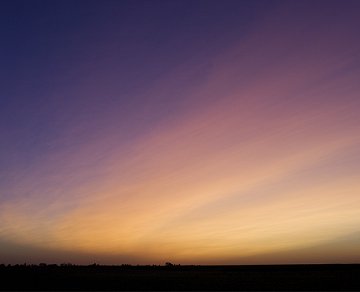| SOLAR WIND: A solar wind stream is buffeting Earth's magnetic field, but it is not stirring up geomagnetic storms or auroras. Geomagnetic activity should remain low. VOLCANIC SUNSETS: People across the USA are reporting unusual sunsets. When the sun goes down, delicate ripples of white appear over the western horizon. Then, as the twilight deepens, the sky turns a telltale shade of "volcanic lavender." Paul Hadfield photographed this example last night, June 28th, from Latham, Illinois: 
The source of the phenomenon is probably Russia's Sarychev Peak volcano. It erupted on June 12th, hurling massive plumes of sulfur dioxide (SO2) and other debris into the stratosphere. The white ripples that herald these sunsets are made of volcanic aerosols--a mixture of ash and sulfur compounds. Blue light scattered by fine volcanic aerosols combines with ordinary red sunset rays to produce the telltale lavender. Earth-orbiting satellites are monitoring Sarychev's sulfur dioxide plume as it circumnavigates the globe at high latitudes, spreading the phenomenon from Russia to the USA to Europe and back again. All northern sky watchers should be alert for volcanic sunsets. 2009 Sarychev Sunset Gallery
[See also: 2008 Kasatochi Sunset Photo Gallery] MAMMATUS OVER MANHATTAN: "Last Saturday, June 26th, after a summer evening thunderstorm, a bank of spectacular mammatus clouds formed over Manhattan," reports Snehal Patel of New York. "It was an amazing display that looked like large orange cotton balls falling from the sky." He took this picture using an iPhone 3G: 
"The most entertaining part of the display was the crowds of people running out of restaurants and lining the streets to catch a glimpse!" Mammatus clouds, named for their resemblance to a cow's underbelly, sometimes appear at the end of severe thunderstorms when the thundercloud is breaking up. Researchers have called them an "intriguing enigma," because no one knows exactly how and why they form. The clouds are fairly common but often go unnoticed because potential observers have been chased indoors by the rain. If you are one of them, dash outside when the downpour stops; you could witness a beautiful mystery in the sky. more images: from Chris Moy of New York City; from Jim and Wendy Scott of Fleetwood, Pennsylvania; from Alex Barnard of New York City; from Marilyn Stern of Manhattan, New York City; from Terry Pundiak of Palmer Township, PA; from Martin Popek of Nýdek, Bystřice nad olší, Czech republic; from Dan Linek of Brentwood, New York;
2009 Noctilucent Photo Gallery
[previous years: 2008, 2007, 2006, 2005, 2004, 2003]
Explore the Sunspot Cycle | 
